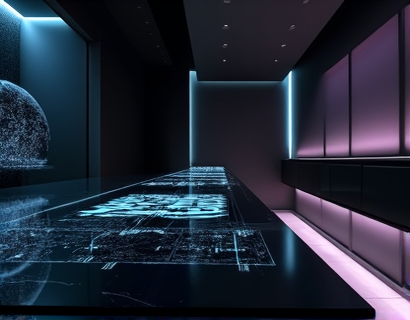Optimizing Architecture Firm Management with Advanced Software Solutions
In the rapidly evolving landscape of the architecture industry, firms are constantly seeking ways to enhance their management practices to stay competitive and deliver exceptional projects. Advanced software solutions have emerged as a transformative force, streamlining internal processes and significantly boosting user experience. These tools enable architects to concentrate on their creative excellence while improving collaboration and productivity. This article delves into the profound impact of innovative platforms designed to optimize project management, resource allocation, and client interactions, providing a significant competitive edge in the modern architecture sector.
Enhancing Project Management
Effective project management is the backbone of any successful architecture firm. Advanced software solutions offer robust project management tools that allow for real-time tracking of project progress, seamless task assignment, and efficient resource allocation. These platforms provide a centralized hub where team members can access project details, deadlines, and milestones, ensuring everyone is aligned and working towards the same goals. By automating routine tasks such as scheduling and reporting, these tools reduce the likelihood of errors and free up valuable time for more strategic activities.
One of the key features of these software solutions is their ability to integrate with other tools and systems used within the firm. This integration ensures a smooth flow of information across different stages of the project lifecycle, from initial conception to final delivery. For instance, design changes can be instantly reflected in cost estimates and timelines, preventing delays and cost overruns. This level of integration not only enhances efficiency but also improves the overall quality of the project outcomes.
Optimizing Resource Allocation
Resource allocation is a critical aspect of firm management that directly impacts project success and client satisfaction. Advanced software solutions provide sophisticated tools for managing human and material resources. These tools enable firms to forecast resource needs, allocate personnel based on skill sets and availability, and monitor workloads to prevent burnout. By ensuring that the right resources are available at the right time, firms can maintain high productivity levels and deliver projects on schedule.
Moreover, these platforms offer detailed analytics and reporting features that help managers make informed decisions about resource utilization. For example, by analyzing historical data, firms can identify patterns and trends that inform future resource planning. This data-driven approach not only optimizes resource allocation but also helps in budgeting and cost control, contributing to the overall financial health of the firm.
Improving Client Interactions
Client satisfaction is paramount in the architecture industry, and advanced software solutions play a crucial role in enhancing client interactions. These platforms provide tools for managing client communications, from initial consultations to project handovers. Secure online portals allow clients to access project updates, view designs, and provide feedback in real-time. This level of transparency and accessibility builds trust and ensures that clients feel involved throughout the project lifecycle.
Additionally, these software solutions often include features for managing client expectations and managing change requests. By providing clear and consistent communication, firms can mitigate misunderstandings and ensure that client needs are met effectively. The ability to track and document client interactions also helps in maintaining a comprehensive record of project history, which is invaluable for future reference and continuous improvement.
Fostering Collaboration
Collaboration is a cornerstone of successful architecture projects, and advanced software solutions are designed to facilitate seamless teamwork. These platforms offer collaborative workspaces where team members can work together on designs, share files, and provide feedback in real-time. This level of collaboration breaks down silos and encourages a more integrated approach to project development.
Version control is another critical feature of these tools, ensuring that all team members are working with the most up-to-date files. This reduces the risk of errors and inconsistencies, leading to higher quality designs. Moreover, the ability to comment and annotate directly on design files streamlines the review process, making it more efficient and effective. This real-time collaboration not only speeds up the design process but also fosters a more cohesive and productive team environment.
Enhancing Productivity
By automating routine tasks and providing powerful tools for project management, resource allocation, and client interactions, advanced software solutions significantly enhance overall productivity. Architects and their teams can focus more on creative and strategic activities, knowing that the administrative burdens are managed effectively in the background. This shift allows firms to take on more projects without compromising on quality or deadlines.
Productivity gains are also realized through the reduction of manual data entry and the minimization of paper-based processes. Digital workflows not only speed up operations but also reduce the risk of human error. The time saved can be redirected towards more value-adding activities, such as innovation and client relationship building, which are essential for long-term success in the architecture industry.
Case Studies and Real-World Applications
Several architecture firms have already experienced the transformative benefits of adopting advanced software solutions. For instance, a mid-sized firm in New York reported a 30% increase in project delivery speed after implementing a comprehensive project management platform. The firm attributed this improvement to the tool's ability to streamline workflows and enhance communication among team members. Another firm in London noted a significant reduction in project costs due to better resource allocation and more accurate cost estimations provided by the software.
These case studies highlight the practical advantages of using advanced software solutions. Firms that have embraced these tools have not only improved their operational efficiency but have also gained a competitive edge in a market where client satisfaction and project delivery are paramount.
Future Trends and Innovations
The architecture software landscape is continually evolving, with new innovations on the horizon. One emerging trend is the integration of artificial intelligence (AI) and machine learning (ML) into project management tools. AI can predict potential issues and suggest optimal solutions, further enhancing project control and quality. ML algorithms can analyze vast amounts of data to provide insights that inform design decisions and optimize resource usage.
Another area of innovation is the use of virtual and augmented reality (VR/AR) in the design process. These technologies, when integrated with software solutions, allow clients to experience designs in a more immersive and realistic way, leading to better decision-making and higher client satisfaction. As these technologies become more accessible and affordable, their adoption in the architecture industry is expected to grow.
Conclusion
In conclusion, advanced software solutions offer a comprehensive approach to optimizing architecture firm management. By streamlining project management, resource allocation, and client interactions, these tools enable firms to enhance collaboration and productivity. The result is a more efficient, effective, and creative work environment that positions firms for success in the modern architecture market. As the industry continues to evolve, embracing these innovative solutions will be crucial for staying ahead of the curve and delivering exceptional projects.










































